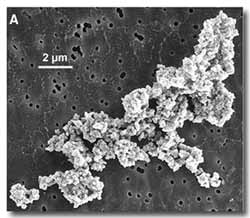Organic molecules transport strongest spectral signature of interplanetary dust particles

A secondary electron image of a typical chondritic Interplanetary Dust Particle (IDP).
Carbon and silicate grains in interplanetary dust particles are helping scientists solve a 40-year-old astronomical mystery.
Using a transmission electron microscope, researchers from Lawrence Livermore National Laboratory have detected a 5.7-electron volt or 2175 Å (angstrom) wavelength feature in interstellar grains that were embedded within interplanetary dust particles (IDPs). They found that this feature is carried by carbon and amorphous silicate grains that are abundant in IDPs and may help explain how some IDPs formed from interstellar materials.
The research appears in the Jan. 14 edition of the research journal Science.
Interplanetary dust particles gathered from the Earth’s stratosphere are complex collections of primitive solar system and presolar grains from the interstellar medium. The strongest ultraviolet spectral signature of dust in the interstellar medium (the gas and dust between stars, which fills the plane of a galaxy) is the astronomical 2175 angstrom feature or “2175 Å bump.” Production of this interstellar feature is generally believed to originate from electronic transitions associated with the surfaces of very small grains.
The carbon and silicate grains may have been produced by irradiation of dust in the interstellar medium. The measurements may help explain how interstellar organic matter was incorporated into the solar system. In addition, they provide new information for computational modeling, laboratory synthesis of similar grains and laboratory ultraviolet photo-absorption measurements.
“Our finding potentially breaks a log-jam in the search for the carrier of the astronomical 2175 Å feature,” said John Bradley, director of Livermore’s Institute for Geophysics and Planetary Physics and lead author of the paper. “Over the past 40 years, a whole variety of exotic materials have been proposed, including nano-diamonds, fullerenes, carbon ‘onions’ and even interstellar organisms. Our findings suggest that organic carbonaceous matter and silicates, the ‘common stuff’ of interstellar space, may be responsible for the 2175 Å feature.”
Other Livermore scientists on the project include Zu Rong Dai, Giles Graham, Peter Weber, Julie Smith, Ian Hutcheon, Hope Ishii and Sasa Bajt.
Outside collaborators include researchers from UC Davis, Lawrence Berkeley National Laboratory, Washington University and NASA-Ames Research Center.
Founded in 1952, Lawrence Livermore National Laboratory is a national security laboratory, with a mission to ensure national security and apply science and technology to the important issues of our time. Lawrence Livermore National Laboratory is managed by the University of California for the U.S. Department of Energy’s National Nuclear Security Administration.
Media Contact
More Information:
http://www.llnl.govAll latest news from the category: Physics and Astronomy
This area deals with the fundamental laws and building blocks of nature and how they interact, the properties and the behavior of matter, and research into space and time and their structures.
innovations-report provides in-depth reports and articles on subjects such as astrophysics, laser technologies, nuclear, quantum, particle and solid-state physics, nanotechnologies, planetary research and findings (Mars, Venus) and developments related to the Hubble Telescope.
Newest articles

Superradiant atoms could push the boundaries of how precisely time can be measured
Superradiant atoms can help us measure time more precisely than ever. In a new study, researchers from the University of Copenhagen present a new method for measuring the time interval,…

Ion thermoelectric conversion devices for near room temperature
The electrode sheet of the thermoelectric device consists of ionic hydrogel, which is sandwiched between the electrodes to form, and the Prussian blue on the electrode undergoes a redox reaction…

Zap Energy achieves 37-million-degree temperatures in a compact device
New publication reports record electron temperatures for a small-scale, sheared-flow-stabilized Z-pinch fusion device. In the nine decades since humans first produced fusion reactions, only a few fusion technologies have demonstrated…





















